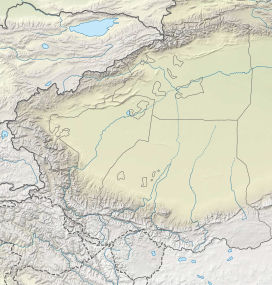The Baltoro Muztagh (simplified Chinese: 巴尔托洛慕士塔格山; traditional Chinese: 巴爾托洛慕士塔格山; pinyin: Bā'ěrtuōluò Mùshìtǎgé Shān, Urdu: بلتورو موز تاغ) is a subrange within the Karakoram mountain range. It spans across the Baltistan region of Gilgit-Baltistan, which is the northernmost political entity of Pakistan, and extends into Xinjiang, China. The crest of this range also serves as part of the border between Pakistan and China.
| Baltoro Muztagh | |
|---|---|
| Chinese: 巴尔托洛慕士塔格山 | |
 | |
| Highest point | |
| Peak | K2 |
| Elevation | 8,611 metres (28,251 ft) |
| Coordinates | 35°52′57″N 76°30′48″E / 35.88250°N 76.51333°E |
| Geography | |
Location of the Baltoro Muztagh within the greater Karakoram region | |
| Countries | Pakistan and China |
| Regions | Gilgit-Baltistan and Xinjiang |
| Parent range | Karakoram |
 | |
The range is home to K2 which has an elevation of 8,611 metres (28,251 ft) above sea level, which is also the second highest mountain in the world. Additionally, it is home to three other eight-thousander peaks, all located on the north and east sides of the Baltoro Glacier.
Selected peaks of the Baltoro Muztagh
editBelow is a list of peaks in the Baltoro Muztagh that exceed 7,000 meters (22,970 feet) in elevation and possess a topographic prominenceof over 500 meters (1,640 feet), a commonly used criterion for considering peaks of this stature as independent.
Lower summits
editThere are a number of lower summits near the tongue of the Baltoro Glacier which are striking rock towers, and are famous for their aesthetic, difficult climbing. These include:
- Great Trango, 6,286 m
- Trango (Nameless) Tower, 6,239 m
- Uli Biaho Tower, 6,109 m
See also
edit
Sources
editJerzy Wala, Orographical Sketch Map of the Karakoram, Swiss Foundation for Alpine Research, Zurich, 1990.
External links
edit- Northern Pakistan detailed placemarks in Google Earth Archived 2012-02-04 at the Wayback Machine


